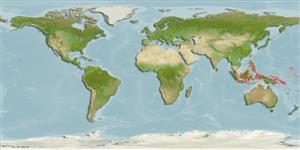>
Ophidiiformes (Cusk eels) >
Dinematichthyidae (Viviparous brotula)
Etymology: Alionematichthys: Name from Latin alius meaning the other or different, and nematichthys, the stem of the genus name Dinematichthys, to which this genus is most similar.; plicatosurculus: Named for the characteristic folded inner pseudoclasper (Latin plicatus for folded and surculus for grapevine tendril used for the term pseudoclasper; noun in apposition..
More on authors: Møller & Schwarzhans.
Environment: milieu / climate zone / depth range / distribution range
Ecologie
marien rifbewoner; diepte 0 - 10 m (Ref. 81230). Tropical
Western Pacific: Philippines, Indonesia, Papua New Guinea and the Solomon Is.
Grootte / Gewicht / Leeftijd
Maturity: Lm ? range ? - ? cm
Max length : 7.9 cm SL mannelijk / geslacht onbekend; (Ref. 81230); 5.8 cm SL (female)
Korte beschrijving
Determinatiesleutels | Morfologie | Morfometrie
Dorsale zachte stralen (totaal) : 76 - 84; Anale zachte stralen: 60 - 67; Wervels: 42 - 45. This species is distinguished by the following characters: D 76-84; A 60-67; moderately large eyes (2.2-3.0%SL); slender body; rounded snout, no cirri; scales only cheeks; upper preopercular pore absent; outer pseudoclasper broad-based, large, sometimes beyond the hood when in resting position, with thickened tip especially on the inner face, while the inner one is large, thick, with posterior lobe folded over anterior pointed lobe; otolith length to height 2.1-2.3, with gently curved dorsal rim; otolith length to sulcus length 1.6-1.7, ostium length to caudal length 3.5-4.5; vertebrae 11-12 + 31-33 = 42-45 (Ref. 81230).
Found on volcanic rock boulders and sandy channels, shallow coral reef (Ref. 81230). Cryptic, solitary inhabitant of shallow water (Ref. 90102).
Levenscyclus en paargedrag
Maturities | Voortplanting | Spawnings | Egg(s) | Fecundities | Larven
Møller, P.R. and W. Schwarzhans, 2008. Review of the Dinematichthyini (Teleostei, Bythitidae) of the Indo-west Pacific, Part IV. Dinematichthys and two new genera with descriptions of nine new species. The Beagle 24:87-146. (Ref. 81230)
Status op de Rode Lijst van het IUCN (Ref. 130435)
Gevaar voor de mens
Harmless
Gebruik door de mens
Visserij: van geen belang
Tools
Speciale rapporten
Download XML
Internetbronnen
Estimates based on models
Preferred temperature (Ref.
123201): 28.2 - 29.3, mean 28.9 °C (based on 786 cells).
Fylogenetische diversiteitsindex (Ref.
82804): PD
50 = 0.5005 [Uniqueness, from 0.5 = low to 2.0 = high].
Bayesian length-weight: a=0.00389 (0.00180 - 0.00842), b=3.12 (2.94 - 3.30), in cm total length, based on all LWR estimates for this body shape (Ref.
93245).
Trofisch niveau (Ref.
69278): 3.3 ±0.5 se; based on size and trophs of closest relatives
Fishing Vulnerability (Ref.
59153): Low vulnerability (10 of 100).
